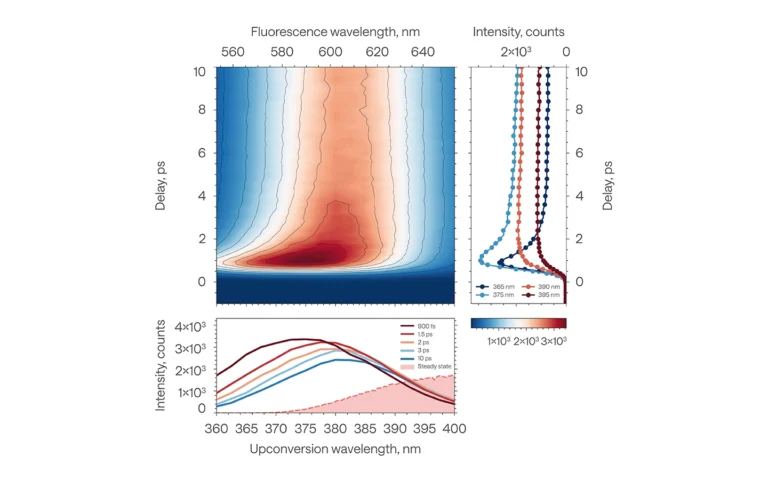时间分辨荧光光谱学
时间分辨荧光光谱学可提供有关激发态分子过程的信息。利用相同的实验装置,多种技术能够在不同时间尺度上测量荧光动力学:
- 克尔门
- 荧光上转换
- 时间相关单光子计数(TCSPC)
- 磷光
光学克尔门技术涉及一束超快激光脉冲(泵浦光)、第二束脉冲(闸门光)以及一种克尔介质。泵浦光脉冲触发目标分子过程。荧光首先通过一个线偏振器。第二个线偏振器(检偏器)与第一个偏振器垂直放置,从而有效阻挡透射的发射信号。在检偏器和偏振器之间放置一种克尔介质。闸门光脉冲记录由泵浦光脉冲引发的光谱变化,它会将克尔介质(通常是各向同性材料)中的双折射特性 “开启”。这种激光诱导的各向异性可持续几百飞秒。在这一短暂的时间窗口内,线偏振荧光光束穿过克尔介质后会发生相移,导致原始荧光光束的去偏振,因此能部分透过正交偏振光学系统。
飞秒时间尺度的荧光光谱常采用光学闸门进行测量。光学闸门的工作原理是对荧光衰减过程进行 “切片”,切片的时间由延迟台决定。该延迟台用于设定泵浦脉冲激发时刻与闸门开启之间的时间间隔。通过使用不同的延迟值重复实验,可获得荧光的衰减轨迹或轮廓。
荧光上转换实验(FU)的时间分辨率更高,但比克尔门技术更复杂。在该实验中,泵浦脉冲在 tPump = 0 时刻将分子系统激发至单重激发态 S1。激发态发出的荧光通常可持续数十或数百纳秒。这种相对较长的荧光信号从发光样品中被收集后,与一束时间宽度短得多的闸门脉冲共同聚焦到 χ(2) 非线性介质中。这会导致两束光波发生和频混频(即上转换)。上转换辐射 (ωupconversion) 的强度与两束相互作用脉冲的时间乘积直接成正比。当我们随时间推移调整闸门脉冲 (tGate = tGate1, tGate2, tGate3, …) 时,这些在时间上依次推进的闸门脉冲会与荧光脉冲包络的不同片段相互作用。由于激光脉冲的时间持续时长远短于荧光信号,闸门脉冲实际上起到了频闪灯的作用,将持续时间长得多的荧光脉冲 “切片”,从而产生强度各异的上转换脉冲。生成的和频信号随后可在光谱设备中通过 “慢” 探测器进行检测。
时间相关单光子计数(TCSPC)是一种电子时域荧光测量技术,其原理基于荧光的概率特性。为便于理解,可将其想象为用一个快速秒表来探测荧光事件:当样品在相对时间 t = 0 被短激光脉冲激发后,经过一段时间 Δt(具有一定概率)会发射出一个荧光光子。如果用多束激光脉冲多次测量激发到发射的时间 Δt,所得到的数值将按照发射概率分布,即能获得荧光衰减曲线。 这一过程可通过下图示意:收集到具有统计意义的单光子探测事件数量后,按光子探测时间对这些事件进行分类,由此生成的直方图便代表了从激发态发射光子的概率,即荧光衰减概率。
HARPIA-TF 是一款用于 HARPIA-TA 光谱系统的时间分辨荧光测量模块,它将克尔门技术或荧光上转换技术与时间相关单光子计数(TCSPC)技术相结合。借助高重复频率的 CARBIDE 或 PHAROS 飞秒激光器,该模块能够在以低至数纳焦耳的脉冲能量激发样品的同时,对荧光动力学进行测量。









